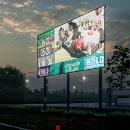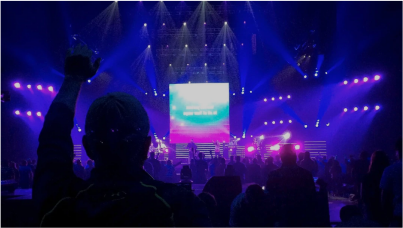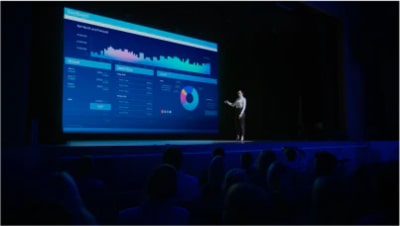What is Pixel Pitch? Definition & Importance in Display Quality
In the world of digital displays, we find ourselves swamped with technical jargon and specifications. But, if there's one term that stands out from the crowd and truly makes its mark in determining the quality of an LED display, it's "Pixel Pitch." Imagine a world where the vividness of an image or the clarity of a message can be compromised by a mere millimeter.
For those of us at Ultravision LED Solutions, it's not just about lighting up pixels; it's about lighting up experiences. We've embarked on a mission to demystify the concept of pixel pitch and to shed light on why it's the hidden gem in the realm of LED displays. So, let's dive deep and uncover the magic behind pixel pitch and its paramount significance in ensuring unmatched display quality.
Pixel Pitch Defined
What is Pixel Pitch?
Pixel Pitch, at its core, is the distance (typically measured in millimeters) from the center of one LED pixel to the center of its adjacent pixel. Imagine a tightly-knit sweater. Each knit or loop is analogous to a pixel in the LED world. The space between these loops, or the tightness of the weave, determines the texture and feel of the sweater. In the same vein, pixel pitch determines the clarity and quality of an LED display. The smaller this distance, the closer the pixels are to each other, forming a more densely packed display.
Relationship Between Pixel Pitch and Resolution
There's a saying that goes, "the devil is in the details." When we talk about resolution, we're referring to the number of pixels contained in a display, expressed in terms of width x height (like 1920 x 1080). Now, the tighter the pixel pitch, the more pixels can fit into a given space, subsequently boosting the resolution.
However, it's not just about stuffing as many pixels into a space as possible. The pixel pitch has to work hand in hand with the display size to achieve optimal resolution. For instance, a gigantic billboard might not need an extremely tight pixel pitch since viewers are often at a greater distance. But for a smaller video wall, where viewers are up-close, a tighter pixel pitch can make a world of difference in perceived clarity.
To put it plainly, the relationship between pixel pitch and resolution is a delicate dance, with each playing a pivotal role in defining the quality of the visual output. Understanding this relationship is key, especially when the goal is to achieve a display that's nothing short of breathtaking.
The Significance of Pixel Pitch in Display Quality
1. Enhancing Visual Clarity and Detail
In the realm of visual displays, every dot and dash counts. Think of a jigsaw puzzle: the more pieces it has, the more intricate and detailed the final image. Similarly, a tighter pixel pitch provides more pixels in a given space, translating to a higher level of detail and clarity in the displayed image.
For businesses, this could mean the difference between a potential client understanding your message instantly or squinting their eyes in confusion. A clear, high-resolution display is essential for presentations, advertisements, or any visual medium where conveying a message or image is paramount.
2. Wide Viewing Angles and Pixel Pitch
The phrase "seeing is believing" holds water, especially in the world of displays. A display's purpose is defeated if it cannot be viewed clearly from multiple angles. Here's where pixel pitch plays a crucial role. Displays with a tighter pixel pitch tend to have better wide-angle visibility. This means that the image quality and color consistency remain stable even when viewed from oblique angles.
Imagine hosting a corporate event with a video wall. Not every audience member will be seated directly in front of the screen. A consistent viewing experience, irrespective of the angle, ensures that everyone is on the same page – a pivotal factor in settings where information dissemination is crucial.
3. Precision Color Reproduction and Pixel Pitch
Color isn't just a visual treat; it's a language in itself. Brands have specific colors associated with their identity. The golden arches of McDonald's or the distinct blue of Facebook are instantly recognizable. The accuracy with which an LED display reproduces these colors is tied intricately to its pixel pitch.
A tighter pixel pitch not only delivers enhanced resolution but also improves color accuracy and uniformity. Each pixel in an LED display contributes to the overall color output. When these pixels are closer together, the blend of colors is more harmonious, resulting in a display that's true to the source and resonates with the intended message.
To sum it up, when pixel pitch hits the sweet spot, it transforms a standard display into an exceptional one, setting the stage for impactful visual communication.
Selecting the Perfect Pixel Pitch for Your Application
1. Assessing Your Display Needs
Before jumping headlong into the pool of pixel pitches available in the market, it's imperative to first gauge the depth of your needs. Just as a fisherman wouldn't use a net to catch a single fish, not every project or venue requires the tightest pixel pitch. The real crux lies in determining your display's primary purpose. Are you aiming for close-up interactions, like in a corporate setting or retail store? Or is it intended for wider audiences, such as digital billboards by highways?
2. Pixel Pitch and Viewing Distance
There's a golden rule in the LED industry: the viewing distance and pixel pitch go hand in hand. Generally, the further away the viewer, the larger the pixel pitch can be without compromising clarity.
For instance, a display meant to be viewed from 10 feet away will require a different pixel pitch than one intended for viewers 100 feet away. Knowing the average viewing distance for your display can provide a compass in the maze of pixel pitch options.
Here are some rules of thumb to keep in mind:
VIEWING DISTANCE
Minimum 1 inch tall character per 50 feet viewing distance
Character: 8 pixels tall; 6 pixels wide
![]()
TYPE OF CONTENT (TEXT, ANIMATIONS, VIDEO)
Text: 8 pixels tall per line of text
Animations: 48 pixels tall x 64 pixels wide
Video: 144 pixels high X 256 pixels wide (16:9 or 1.78)
144 pixels high x 192 pixels wide (4:3 or 1.33)
3. Practical Guidelines for Pixel Pitch Selection
While there's no one-size-fits-all answer, there are some thumb rules to steer you in the right direction:
- Close Proximity Displays (2-10 feet): Ideal for indoor settings like retail stores, boardrooms, and lobbies. Opt for pixel pitches ranging from 0.9mm to 2.5mm.
- Medium Distance Displays (10-50 feet): Suitable for larger indoor venues or closer outdoor settings. Here, pixel pitches between 2.5mm to 6mm are your best bets.
- Far Distance Displays (50 feet and beyond): Think large-scale outdoor billboards or stadium displays. Here, you can lean on pixel pitches from 6mm to 16mm.
4. Maximizing ROI Through Pixel Pitch Optimization
Your LED display isn't just a purchase; it's an investment. And like all investments, the goal is to garner maximum returns. By tailoring the pixel pitch to the specific needs of your venue or purpose, not only do you ensure top-notch visual quality, but you also optimize costs. There's no sense in shelling out extra for ultra-fine pixel pitches if your display is high above on a billboard, just as skimping on pixel pitch for an indoor video wall might leave viewers underwhelmed.
In the grand tapestry of LED displays, each thread, or in this case, pixel, plays its part. By weaving them together optimally, you pave the way for visuals that don't just capture eyes, but also hearts and minds.
How Does Pixel Pitch Affect Video Wall Cost?
Peeling back the layers of LED displays, one quickly discovers that cost isn't just a matter of size or brand. It's a dance of various factors, and pixel pitch leads this waltz. Understanding the intricacies of pixel pitch and its impact on costs can provide clarity when budgeting for your LED project.
At its core, pixel pitch refers to the density of pixels. Tighter pixel pitches mean more LEDs per unit area, which translates to higher production costs. Here's the lowdown:
- Material Costs: The tighter the pixel pitch, the more LED diodes are required for a given display area. Naturally, more components result in a steeper price tag. It's a simple equation: more LEDs mean more costs.
- Manufacturing Complexity: Crafting a display with a fine pixel pitch is no walk in the park. The precision and meticulousness required ratchet up the manufacturing complexity, and this intricacy can influence the final cost.
- Enhanced Electronics: Displays with tighter pixel pitches demand more advanced electronics to manage the increased pixel density effectively. Think of it as needing a more powerful engine for a high-performance car.
- Power Consumption: While advancements in technology have made LEDs more energy-efficient, a display with a finer pixel pitch, packed with more LEDs, will naturally consume more power than one with a broader pitch. This consideration stretches beyond the initial purchase price and touches on long-term operational costs.
However, it's crucial to not let cost considerations tunnel your vision. The old adage "you get what you pay for" holds water here. Investing in a display with the right pixel pitch for your needs can pay dividends in display quality, viewer engagement, and overall impact.
In the end, while it's tempting to cut corners, especially when faced with budget constraints, it's essential to weigh the long-term benefits against short-term savings. After all, a display is not just about lighting up pixels; it's about illuminating messages, values, and visions.
Real-World Implications for Business Owners and Marketing Managers
In the ever-evolving arena of advertising and brand promotion, the devil truly is in the details. And in the world of digital displays, pixel pitch stands as a paramount detail, serving as the backbone of a successful marketing strategy. For business owners and marketing managers, having a keen understanding of pixel pitch isn’t just technical jargon—it’s a key to unlocking the potential of their promotional campaigns.
1. How the Right Pixel Pitch Can Influence Ad Effectiveness
Ever walked past a billboard and squinted to discern its message? Or, conversely, stood close to a video wall at a trade show and felt bombarded by an overwhelming sea of pixels? These scenarios highlight the essence of ad effectiveness tied to pixel pitch.
If your ad is situated in a high foot traffic area, where viewers are mere feet away, a tighter pixel pitch is indispensable. This ensures that even at close proximity, the visuals remain crisp and the messages crystal clear. On the other hand, for billboards positioned high above highways, a broader pixel pitch would suffice, since the average viewer would be yards away, and the finer details would be lost in translation.
It's the age-old principle of right place, right time. In this case, it's about having the right pixel pitch for the right viewing distance.
2. The Role of Pixel Pitch in Strategic Location Placements of Digital Billboards
Location, location, location! Just as this mantra rings true in real estate, it’s equally pertinent in digital advertising. The placement of your digital billboard determines its visibility and, in turn, its effectiveness.
For billboards stationed in bustling city squares or busy intersections, where viewers are both on foot and in vehicles, a mid-range pixel pitch might be the golden mean, striking a balance between clarity and cost-effectiveness.
On the flip side, if your billboard overlooks a freeway, viewers will only catch a fleeting glimpse. Here, the pixel density can be more forgiving, since drivers and passengers won't be zeroing in on the minutiae.
In essence, understanding the strategic interplay between pixel pitch and location can be the difference between your ad fading into the urban backdrop and it standing out, loud and clear. It’s not just about lighting up a screen; it’s about ensuring that every pixel plays its part in conveying your brand's message.
Ultravision's Led billboards provide an unforgettable, attention-grabbing solution for all your business and advertising endeavors. Learn more about our DIgital LED Billboards here.
3. Saving on Costs without Compromising on Quality
No one wants to throw money down the drain. Especially not business owners and marketing managers operating on tight budgets. Investing in digital displays, whether for advertising or informational purposes, should never feel like a gamble. It's about spending wisely, not necessarily spending more. Understanding pixel pitch is pivotal to this fiscal prudence.
When you grasp the correlation between pixel pitch and viewing distance, you're armed with the knowledge to choose the right LED solution that meets your needs without paying for unnecessary precision. For instance, why splurge on a high-density pixel pitch for a scoreboard in a large stadium? The viewers are seated far away, and a fine pixel detail won't make a significant difference from that distance.
At Ultravision LED Solutions, we don't just offer products; we offer tailored solutions. We guide our clients in selecting the optimal pixel pitch for their specific needs, ensuring they get the best bang for their buck.
4. Enhancing Brand Perception with the Right Display Choice
First impressions last. In the world of digital advertising, the quality of your display can shape perceptions of your brand. Imagine showcasing a luxury product on a digital display where the colors are off, or the image resolution is poor. It doesn’t paint a pretty picture, does it?
Having the appropriate pixel pitch ensures your advertisements and announcements look their best. If your brand stands for excellence, your digital displays should echo that sentiment. A well-calibrated LED display radiates professionalism and attention to detail, qualities that customers appreciate and remember.
Furthermore, in the digital age where consumers are more discerning and have a plethora of choices at their fingertips, the clarity and quality of your visuals can be the difference between being scrolled past or being noticed.
In Conclusion: The Power of an Informed Choice
Pixel pitch might come across as a mere technical specification, one of many in the vast realm of digital displays. But as we've delved deep into its intricacies, it's evident that this tiny detail holds enormous sway over the efficacy of our advertising efforts.
By making informed decisions about pixel pitch, businesses not only optimize their advertising reach but also streamline costs and bolster brand image. A trifecta of benefits that any savvy business owner or marketing manager would be eager to harness.
At Ultravision LED Solutions, our mission transcends mere sales. We aim to empower our clients with the knowledge and tools they need to shine brightly in a competitive marketplace. With our extensive range of LED solutions, paired with a deep understanding of pixel pitch dynamics, we stand as a beacon for businesses seeking to illuminate their brand stories with unmatched clarity.
Ultravision LED Solutions and Pixel Pitch Perfection
Navigating the intricate web of LED displays can seem like venturing into a maze blindfolded. With numerous specifications to consider, the quest for the perfect solution can quickly become overwhelming. Yet, amidst the noise and neon of the digital world, there stands a guiding star: Ultravision LED Solutions. Let's illuminate how we champion pixel pitch perfection and why it's a game-changer for our esteemed clientele.
1. Tailored Recommendations for Every Client
Every business, event, or location has its unique requirements. While one brand might benefit from a super-fine pixel pitch due to close viewer proximity, another might find it excessive. We understand these nuances. At Ultravision, we put our clients' needs at the forefront. Instead of taking a one-size-fits-all approach, we pride ourselves on crafting bespoke LED solutions. By gauging your specific goals, target audience, and installation site, we recommend the pixel pitch that aligns perfectly with your vision.
2. Mastery in LED Technology
Over the years, we've not just stayed afloat but have thrived in the rapidly advancing tide of LED technology. This isn't just due to our state-of-the-art products, but because we have made continuous learning and innovation our business's backbone. We don't rest on our laurels. Our commitment to staying abreast of the latest trends and technological advancements means that our solutions always resonate with pixel pitch precision.
3. Transparent Client Conversations
We believe that an informed client is an empowered one. While pixel pitch is a technical concept, we break it down in digestible terms. Our experts take the time to explain, educate, and guide clients, ensuring they fully grasp how pixel pitch will impact their display's efficacy. This transparency fosters trust, ensuring our clients know they're making a decision grounded in understanding, not just a sales pitch.
4. A Legacy of Excellence
At Ultravision LED Solutions, we're not newcomers to the LED arena. Our track record speaks for itself. From digital billboards gracing bustling city centers to scoreboards witnessing roaring crowds, our LED displays have illuminated countless spaces. And in each of these projects, pixel pitch perfection was a paramount consideration, ensuring our displays deliver visuals as envisioned.
5. After-sales Support and Guidance
Our relationship with clients doesn’t conclude with a sale. We stand by our products and the choices we help our clients make. Should you have any queries or require further adjustments post-installation, our dedicated team is always on standby. With Ultravision, you're not just purchasing an LED display; you're investing in a partnership committed to your success.
In the grand tapestry of digital displays, the minutiae, like pixel pitch, can shape the larger picture. At Ultravision LED Solutions, we're not just providers; we're partners in your journey to digital display excellence. Trust us to light the way to pixel pitch perfection.










